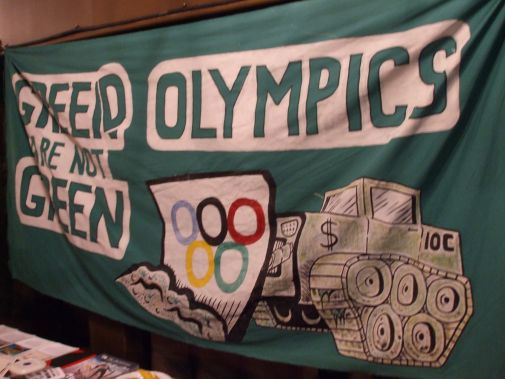Where's the 2010 Olympics Green Legacy?
Where's the 2010 Olympics Green Legacy?
By Pina
February 14, 2009, Word of the Rings blog, rabble.ca
(My letter to the editor that ran in the Pique Newsmagazine & Whistler Question).
As Whistler gets ready to celebrate the one-year countdown to the 2010 Olympics, it’s time to evaluate how the “greenest Games ever” have fared so far.
• Completion of the Callaghan Valley has come with a hefty price. Between 89,000 and 120,000 old-growth trees were cut for the legacy trails and ski jumps. VANOC still refuses to commit to a grizzly bear rehabilitation legacy. However, the subdivision-size trails combined with EPCOR’s new sewage treatment plant are ready to service a four-season resort to duplicate Whistler, post-2010 — a developer's dream come true via the taxpayer’s purse.
• Over 800 trees were cut on Lot 1/9 for the “temporary” Celebration Plaza. VANOC has now scrapped the medals plaza as a cost-saving measure and we’re stuck with a yellow-fenced mud pit, suitable for 4x4 monster truck rallies.
• The red-listed Nesters wetland was destroyed to house the experimental refueling depot. Now B.C. Transit is stalling on its budgets and delivery timelines and rumours are swirling that the hydrogen buses will never materialize. Freedom of Information (FOI) documents from DND indicate that part of the site will house 400 military personnel during the Games. Good use of a wetland.
• Whistler's little “white elephant” — the Whistler Sliding Centre — cost $104.9 million and uses 100 kilometres of ammonia refrigeration piping and 68,000 kilograms of ammonia to keep the track frozen. This “fridge in the sky” requires the same amount of energy to operate as Whistler and Blackcomb mountains combined!
The Cesana Bariol Sliding Centre in Torino requires $1.1. million US annually to operate and maintain, and local residents are already complaining about ammonia leaks. In these economic times, will the Whistler Legacies Society have the funds to operate this facility and are processes in place for ammonia leaks?
At first, we believed we could hold a world-class event with minimal impact on the environment, since ski resorts are the most vulnerable to climate change. Now it’s clear that the 2010 Games are awash in “green” and that Whistler has no lasting environmental legacy.
There’s nothing innovative about clearing every tree in site. Recycling, composting or building venues to LEED standards is not innovative — but simply following the norm. Where are the solar panels, the composting toilets, electric cars and green jobs that can be showcased to the world?
While I commend athletes for pressuring VANOC for carbon-neutral Olympics, the IOC cannot continue to destroy the global environment for corporate gain. Why not recycle sports infrastructure by establishing one set of facilities per country (or continent)?
While we ponder what we have lost forever, on Feb. 12, enjoy a piece of “free” 2010 countdown cake and wash it down with a glass of Kool-Aid.
P. Belperio
Whistler, BC
